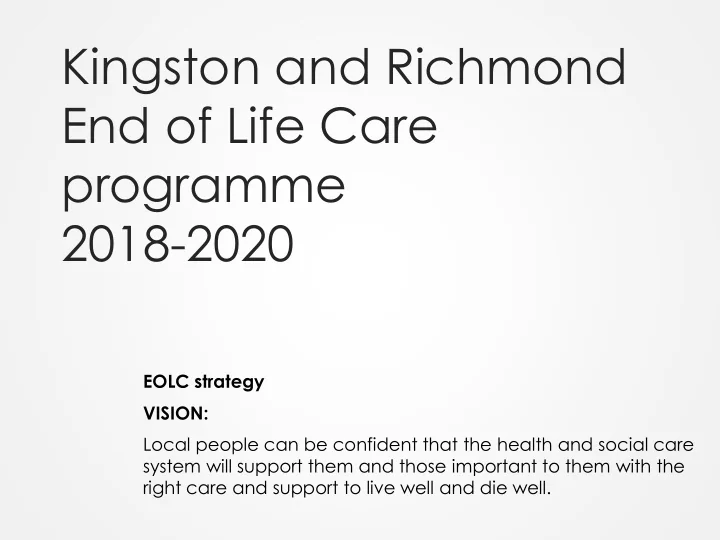

Kingston and Richmond End of Life Care programme 2018-2020 EOLC strategy VISION: Local people can be confident that the health and social care system will support them and those important to them with the right care and support to live well and die well.
Facts and Figures 0.6% of both Kingston & Richmond population die each year. = 1,300 deaths per annum in 2016-17. So about 3 people per day in each area. Approx 52% will die in the community and 48% in hospital Of the 48% that die in hospital (at least 40% of these are expected deaths) = therefore about 250 patients in each area (Public Health England 2014). Many of these patients will have had 2-3 admissions in the previous year. Less than one in five patients (19%) with a shared care plan spend their last days in hospital, compared to almost 50% nationally.
Journey Kingston and Richmond EOLC strategies have been refreshed and combined – joint work since September 2017 Active & inclusive EOLC Steering Group Definition of EOLC in its broadest sense Scope of strategy is for all ages and residents of Kingston & Richmond. Close work with specialist paediatric teams. Quality Improvement Methodology to drive and monitor progress Clear Aims & Objectives Measurable Outcomes. Dashboard of indicators monitored by steering group. Work streams. Some are in place, others evolving. Work alongside other local strategies relevant to EOLC. SWL plans, Complex needs and primary care strategies, etc.
Areas we want to improve Improve information sharing. Improved co-working and coordination within and between organisations. Improve discharges and fast tracking processes. Training and education. Support for carers. Access for all to EOLC.
Core focus will be on five broad objectives ……… compassionate community development, person-centred and holistic advance care planning, improving experience for patients and those important to them as well as frontline staff, reducing inequalities and effective commissioning for end of life care.
Outcomes 1. Local people are supported to live well in the way they want to when they are approaching the end of their life, and after bereavement. 2. Local people in the last phase of their lives receive good quality coordinated care, where possible, aligned with their holistic preferences, enabling them to have a peaceful and dignified death. 3. The local community will be more resilient to care by developing partnerships between the community and professional services.
Our priorities for 2018-20 By March 2019 we will: Have achieved evidence of ground up frontline change with collaborative and participatory development of care and services and: Make available access to training for advance care planning to all primary care, community and hospital staff Have supported clinicians to feel more confident in earlier identification of people approaching the last phase of life Support all GP practices, community and hospital providers to be actively accessing shared advance care records such as coordinate my care (CMC). Have increased the numbers of people that are offered the opportunity to have a Coordinate my Care record which provides an opportunity to discuss and document choice. Support Care home staff and GPs to identify residents who are entering last year of their life and offer advance care plans that are recorded and shared on Coordinate my Care. Have reduced the episodes of unplanned hospital care that patients experience in their last year of life Have reviewed the bereavement and carer support available outside of hospices Have sought feedback from patients and carers on their experiences By March 2020: All people who have predictable deaths will be offered in a timely manner and be involved in, their advance care planning. There will be improved mechanisms for coordinating personalised care planning when patients need to move between care settings, especially hospital discharges.
Kingston and Richmond EOLC strategy plan on a page 2017-2020 v3 All local people can be confident that the health and social care system will give them and Vision those important to them the right care and support to live well and die well. Evidence-based using Quality Improvement methodology and SMART objectives Core Participation and co-production with frontline staff, people who are in the last phase of their approach life and those important to them. 1. Local people can live well in the way they want to when they are approaching the end of their life, and after bereavement. 2. Local people in the last phase of their lives receive good quality coordinated care, where possible, aligned with their holistic Outcomes preferences, enabling them to have a peaceful and dignified death. 3. The local community will be more resilient to care by developing partnerships between the community and professional services. Compassionate Community Experience: Advance Care Planning: Objectives Development: To achieve qualitative feedback High Quality Commissioning Equality: To achieve, that all people who To build local resilient each year on care, experience of To reduce inequalities Education and Training have predictable deaths, community networks to help death, dying and loss across in variations of end of including frailty, will be offered support people through life settings in order to improve life care. Data Analysis and be involved in their advance crises, loss, dying and death, experience or health and care care planning (2018-2020). both inside and outside of services. health and care services. IT Work streams Community development Patient ACPs in primary ACPs in Vulnerable and hard to Compassionate City Charter & community Family & Carer secondary care reach groups care Workforce Transformation Staff
Recommend
More recommend